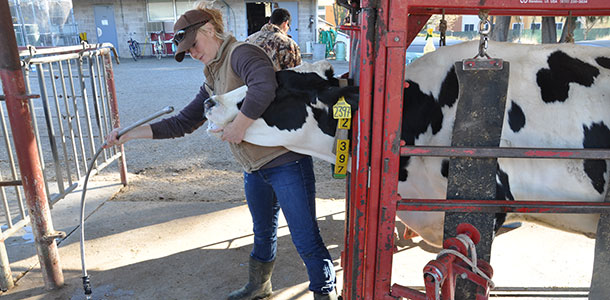Rumen transfaunation involves the collection of rumen fluid from a healthy animal that will be transferred to a sick recipient animal. The following is a description of what might be described as best management practices for transfaunation.
Source cow
Collection of large volumes of rumen fluid is most easily accomplished using a rumen fistulated animal. Removal of rumen fluid is less stressful when the donor is fistulated than by stomach tubing a non-fistulated donor. Typically fistulated animals are housed and managed within the herd so there is limited risk of introducing unknown diseases and the rumen fluid reflects the diets fed on the dairy.
There are reports where rumen fluid was obtained during abattoir slaughter or at post mortem. However, using a non-screened donor from an abattoir may introduce infectious agents, for example Mycobacterium avium var paratb, salmonella, Cryptospordia or E. coli (0157:H7).
Volume
Recommendations vary from 8 to 16 liters for adult cattle and 1 liter for calves. In our research at University of California – Davis, we used 10 to 11 liters of strained rumen fluid for adult cattle.
Timing
Rumen fluid should be transferred as soon as possible after collection. However, recommendations in the literature vary from within 30 minutes of collection to storage for up to nine hours at room temperature or for 24 hours at refrigeration temperature. In one study, storing rumen fluid under CO2 at 0oC for three to six hours did not affect fermentation characteristics; in another study, storing at 0oC for 24 hours decreased fermentation characteristics. Best practice would be to transfer the rumen fluid as soon as possible.
pH
The pH of the rumen fluid should preferably be 6.0 or greater. This can easily be tested with pH paper. Rumen protozoa are decreased at low pH. Typically rumen fluid pH is lowest two to four hours after feeding with high starch diets that are fed to lactating cows, so avoid collecting rumen fluid within about four hours of feeding when the donor is receiving forage and concentrate ingredients used in lactating cow diets. With non-lactating cows that are fed a high forage diet, rumen fluid collection from a fistulated cow can be done prior to feeding or about two to three hours after feeding since pH does not change as dramatically with high forage-based diets and non-lactating cows are consuming less total dry matter than lactating cows. When using lactating cows with rumen fistulas, rumen fluid collection prior to feeding will likely provide rumen fluid above 6.0 pH.

Filter
Filter or strain large particulate matter from the rumen fluid using a screen (authors’ recommendation) to remove large particles that can plug the stomach tube. The filtered material should contain small particles and their associated attached bacteria, protozoa and fungi, along with the microorganisms that are associated with the liquid portion.
Color
Color of normal rumen fluid varies between olive to yellow-brown depending on the diet. One should avoid using foamy or frothy rumen fluid for transfaunation.
Microscopic examination
Microscopic examination of protozoa can be performed prior to transfaunation. Protozoa are visible using a transition microscope. In healthy rumen fluid, the ciliated protozoa should be motile. Microscopic evaluation of rumen fluid is generally impractical on a farm because of the time and labor needed for examination. Microscopic evaluation, in fact, is likely of little importance when the rumen fluid is transferred soon after collection.
Methylene blue test
Rumen fluid is highly reductive, so consequently, addition of methylene blue to the fluid and timing the change of color from its normal blue (oxidized) to a colorless state (reduced) can serve as an indirect measure of viability in the harvested rumen fluid. The test is performed by adding 0.5 ml of a 0.03 percent methylene-blue solution to 10 ml of rumen fluid in a test tube followed by mixing. A healthy rumen environment is highly reduced (high [H+] concentration). The blue color of the methylene blue should disappear within about five minutes or less. If it takes longer than 10 minutes for the color to disappear, it is probably best to discard the rumen fluid. Methylene blue has more application as a test of quality if the rumen fluid is stored for periods of time prior to transfer to the recipient. PD
E.J. DePeters
Department of Animal Science
University of California – Davis
L.W. George
School of Veterinary Medicine
University of California – Davis
PHOTO
PHOTO 1: Sampling can be done using a PVC pipe with holes to reach the ventral rumen. The ventral rumen contains more fluid.
PHOTO 2: A stomach tube is passed orally down the esophagus into the reticulo-rumen. Photos provided by E.J. DePeters.








